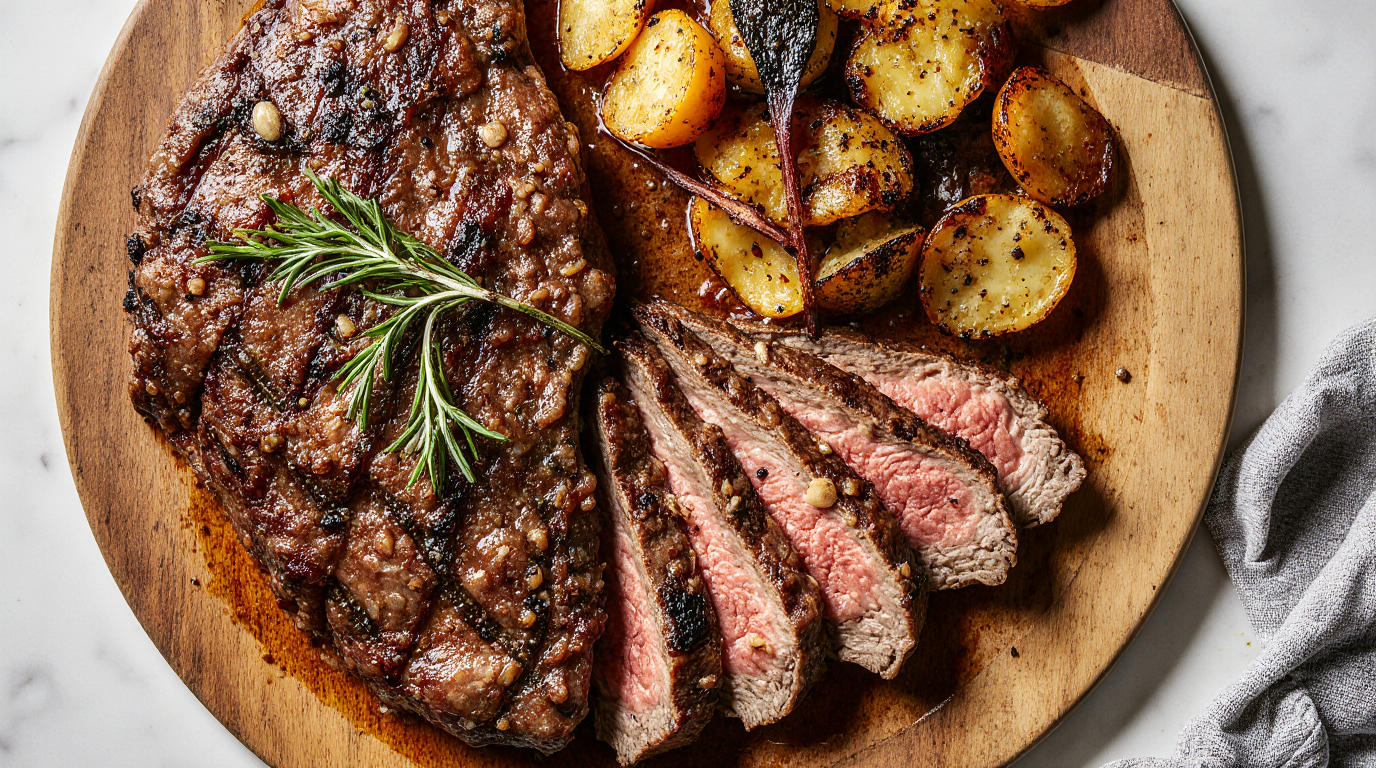How to Cook Beef Chuck Eye Steak – Juicy & Flavorful Every Time
Cooking a chuck eye steak to perfection can be a challenge, but with the right techniques, you can achieve a juicy and flavorful result every time.
I have discovered that the key to cooking a great chuck eye steak lies in understanding the different cooking methods and choosing the one that suits your taste preferences.
In this article, we will explore various ways to cook a beef chuck eye steak, ensuring that you can enjoy a tender and delicious meal.
Key Takeaways
- Learn the best cooking methods for a juicy and flavorful chuck eye steak.
- Discover the importance of proper cooking techniques.
- Explore different ways to season and marinate your steak.
- Understand how to achieve the perfect doneness.
- Get tips on how to cook a chuck eye steak to perfection.
What is Beef Chuck Eye Steak?
The beef chuck eye steak is a lesser-known relative of the ribeye, offering similar qualities at a different price point. It’s a cut that has garnered attention for its rich flavor profile and tender texture, making it a favorite among steak enthusiasts.
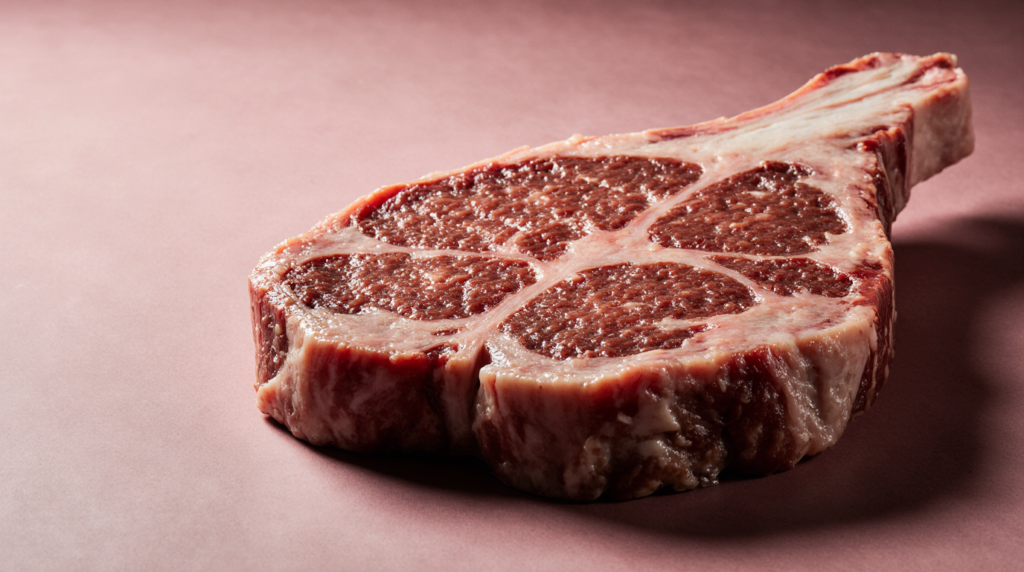
Anatomy of the Chuck Eye Cut
The chuck eye steak originates from the chuck section of the cow, near the rib area. Understanding its anatomy is crucial to appreciating its value.
Location on the Cow
The chuck eye is located at the boundary between the chuck and rib sections, making it a transitional cut that combines characteristics of both.
Muscle Structure and Fat Content
The muscle structure of the chuck eye steak is less complex than some other cuts, but it is well-marbled, which contributes to its tenderness and flavor. The fat content is moderate, enhancing the overall juiciness when cooked properly.
Why It’s Called the “Poor Man’s Ribeye”
The chuck eye steak is often referred to as the “poor man’s ribeye” due to its similarity in taste and texture to the ribeye, but at a generally lower price. This comparison is largely due to its similar marbling and the tender, rich flavor it offers.
| Characteristics | Chuck Eye Steak | Ribeye Steak |
|---|---|---|
| Location | Chuck/Rib Section | Rib Section |
| Marbling | Moderate | High |
| Price | Generally Lower | Generally Higher |
Why Choose Chuck Eye Steak
If you’re seeking a steak that’s both affordable and packed with flavor, the chuck eye steak is the way to go. This cut of beef is gaining popularity among steak enthusiasts, and for good reason.
Flavor Profile
The chuck eye steak boasts a rich flavor profile that’s characteristic of the ribeye, but at a lower price point. Its marbling contributes to its tenderness and juiciness, making it a delight to eat.
Value Proposition
One of the key advantages of the chuck eye steak is its value proposition. It offers a similar dining experience to more expensive cuts like the ribeye, but without the hefty price tag. This makes it an attractive option for those looking to enjoy a high-quality steak without breaking the bank.
Versatility in Cooking Methods
The chuck eye steak is also incredibly versatile when it comes to cooking methods. Whether you prefer to grill, pan-sear, or sous vide your steak, the chuck eye steak can be cooked to perfection using a variety of techniques. Experimenting with different chuck eye steak seasoning and chuck eye steak recipe ideas can further enhance its natural flavor.
Chuck Eye vs Ribeye: Understanding the Differences
The world of steak is rich with options, but chuck eye and ribeye stand out for their unique qualities. When deciding between these two popular steaks, several factors come into play, including taste, texture, marbling, and price.
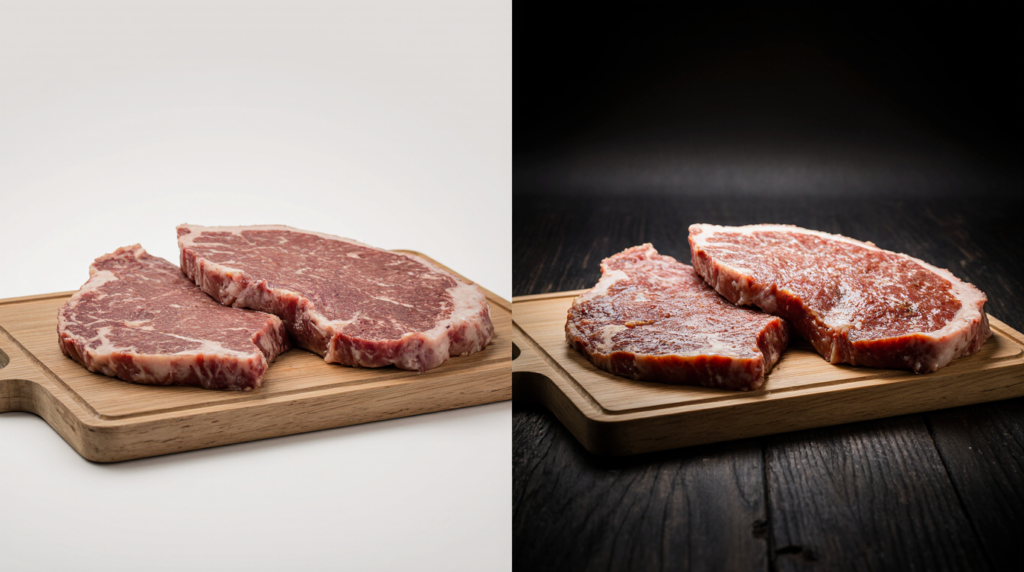
Taste Comparison
The taste of chuck eye and ribeye steaks differs due to their distinct fat content and marbling. Ribeye, known for its rich marbling, tends to have a more intense beef flavor. In contrast, chuck eye, while still flavorful, has a slightly leaner taste profile.
Texture and Marbling Differences
Marbling refers to the intramuscular fat that disperses throughout the meat, contributing to its tenderness and flavor. Ribeye generally has more marbling than chuck eye, making it tender and juicy. Chuck eye, however, still offers a tender bite, albeit slightly firmer than ribeye.
Price Point Comparison
One significant difference between chuck eye and ribeye is their price. Chuck eye is generally more affordable, making it an attractive option for those seeking a high-quality steak without the high cost. Ribeye, being more premium, comes with a higher price tag.
When to Choose Each Cut
Choose chuck eye for a flavorful, tender steak on a budget. Opt for ribeye when you’re looking to indulge in a richer, more luxurious dining experience. Ultimately, the decision between chuck eye and ribeye depends on your personal preferences and the occasion.
Selecting the Perfect Beef Chuck Eye Steak
The key to a mouth-watering beef chuck eye steak lies in its selection, and I’m here to guide you through it. When you’re at the butcher counter, there are several factors to consider to ensure you’re getting a high-quality cut.
What to Look for at the Butcher Counter
First, you need to inspect the steak’s appearance. Color and freshness are crucial.
Color and Freshness Indicators
Look for a rich, vibrant red color. Avoid steaks with brown or grayish hues, as they may be past their prime.
Marbling Assessment
Check for marbling, the intramuscular fat that’s dispersed throughout the meat. A good chuck eye steak should have a decent amount of marbling, which enhances flavor and tenderness.
Grading Considerations
USDA grading is another important factor. Prime, Choice, and Select are the most common grades. Prime offers the highest marbling content, while Select is leaner.
Thickness Recommendations
A thickness of about 1-1.5 inches is ideal for chuck eye steaks, allowing for even cooking.
| Grade | Marbling | Tenderness |
|---|---|---|
| Prime | Abundant | Very Tender |
| Choice | Moderate | Tender |
| Select | Less | Less Tender |
Essential Tools for Cooking Chuck Eye Steak
To achieve a perfectly cooked chuck eye steak, you’ll need a few key tools in your kitchen arsenal. The right equipment can elevate your cooking experience and ensure a deliciously cooked steak every time.
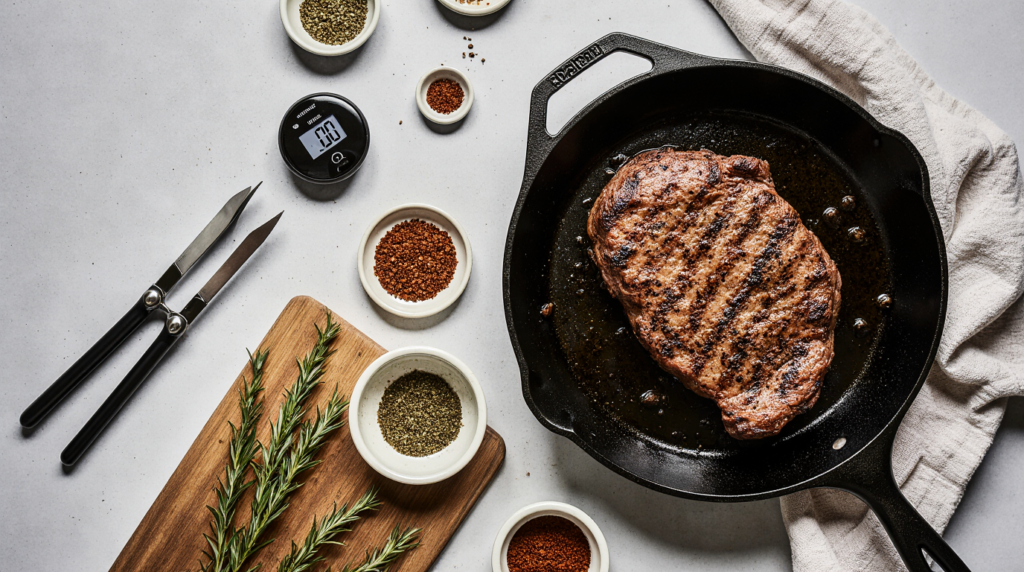
Cookware Recommendations
When it comes to cookware, there are a couple of options that stand out for cooking chuck eye steak. Cast iron skillets are highly recommended due to their ability to retain high heat and distribute it evenly.
Cast Iron Skillet Benefits
A cast iron skillet can achieve a perfect sear on the steak, locking in juices and flavors. It’s also versatile, allowing for both stovetop and oven use.
Grill Setup Options
For those who prefer grilling, having a reliable grill setup is essential. This includes a grill with good heat control and a clean, well-oiled grate to prevent sticking.
Temperature Monitoring Tools
Accurate temperature control is crucial when cooking chuck eye steak. Using a meat thermometer ensures that your steak is cooked to your desired level of doneness.
Additional Helpful Utensils
Other useful tools include tongs or spatulas for flipping the steak and a cutting board for slicing after cooking. These tools can make the cooking process smoother and more efficient.
Preparing Your Beef Chuck Eye Steak
The key to a mouth-watering beef chuck eye steak lies in its preparation. Proper preparation ensures that your steak is not only flavorful but also tender and juicy.
Trimming and Tenderizing
Start by trimming any excess fat from the steak, leaving a thin layer to enhance flavor. Tenderizing the steak can be done using a meat mallet or by scoring the fibers with a sharp knife.
Bringing to Room Temperature
Before cooking, it’s essential to bring your beef chuck eye steak to room temperature. This helps in achieving a more even cook.
Dry Brining Technique
Dry brining involves seasoning the steak with salt and letting it sit.
Salt Timing and Quantity
Use about 1-2% of the steak’s weight in salt. Apply the salt evenly and let it sit for at least an hour.
Benefits for Moisture Retention
Dry brining enhances moisture retention, resulting in a juicier steak. The salt helps to break down proteins, making the steak more tender.
| Preparation Step | Benefit |
|---|---|
| Trimming excess fat | Enhances flavor and texture |
| Tenderizing | Makes the steak more tender |
| Bringing to room temperature | Ensures even cooking |
| Dry brining | Improves moisture retention and flavor |
Chuck Eye Steak Seasoning and Marinades
Unlock the full flavor potential of your chuck eye steak with expert seasoning and marinating techniques. The right blend of spices and marinades can elevate this cut of beef to new heights, making it a standout dish.
Basic Seasoning Combinations
A simple yet effective way to season your chuck eye steak is by using a mix of salt, pepper, and garlic powder. You can also add a sprinkle of paprika for a smoky flavor. For a more robust taste, consider combining thyme, rosemary, and a hint of cayenne pepper.
Tip: Always season your steak just before cooking to ensure the flavors adhere well to the meat.
Marinade Recipes for Enhanced Flavor
Marinades can add depth and complexity to your chuck eye steak. There are two primary types of marinades: acidic and oil-based.
Acidic Marinades for Tenderizing
Acidic marinades, which include ingredients like vinegar or citrus juice, help tenderize the steak. A classic recipe involves mixing lemon juice, olive oil, minced garlic, and herbs like parsley and thyme.
Oil-Based Marinades for Moisture
Oil-based marinades, on the other hand, help retain moisture in the steak. A simple oil-based marinade can be made with olive oil, soy sauce, and a touch of honey for a hint of sweetness.
Dry Rub Options
Dry rubs offer another flavorful alternative to marinades. A dry rub made from brown sugar, smoked paprika, garlic powder, and salt can create a delicious crust on your chuck eye steak.
Timing Guidelines for Maximum Flavor
The timing of your marinade or dry rub application is crucial. For marinades, allow at least 2 hours, but ideally overnight, for the flavors to penetrate the meat. For dry rubs, apply them at least 30 minutes before cooking.
By following these seasoning and marinade guidelines, you can significantly enhance the flavor of your chuck eye steak, making it a truly memorable dining experience.
Pan-Searing Chuck Eye Steak to Perfection
The pan-searing method is a straightforward yet nuanced approach to cooking a chuck eye steak that yields a deliciously caramelized crust. This technique, when executed correctly, brings out the rich flavors and tender texture of the steak, making it a favorite among steak enthusiasts.
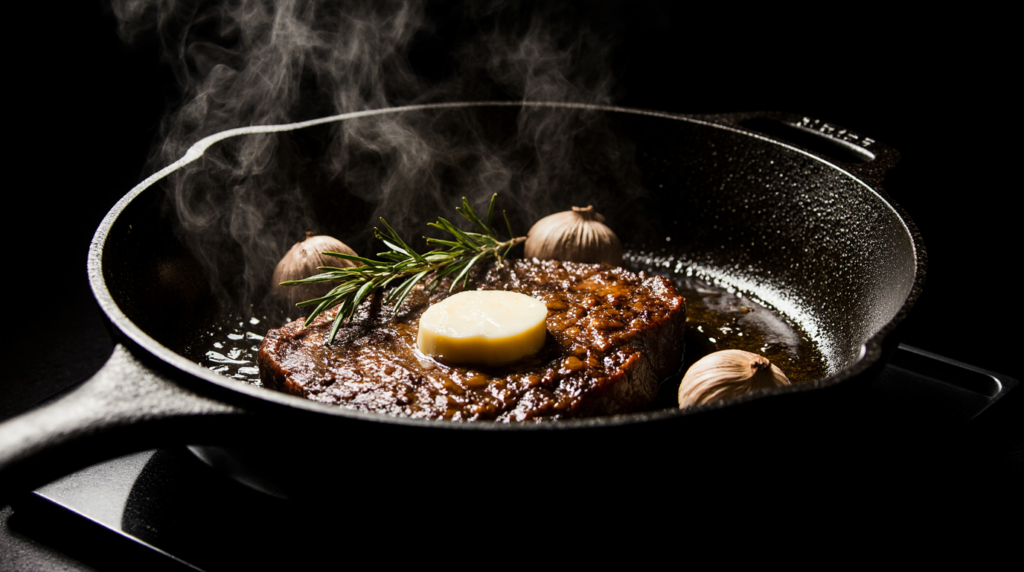
Step-by-Step Pan-Searing Method
To pan-sear a chuck eye steak effectively, follow these steps carefully. First, preheat your pan to the right temperature.
Preheating Your Pan Properly
Preheating the pan is crucial for achieving a good sear. Use a skillet or cast-iron pan over high heat until it reaches a smoking hot temperature. This process usually takes about 5-7 minutes. You can test the heat by flicking a few drops of water onto the pan; if they sizzle and evaporate quickly, the pan is ready.
Oil Selection and Smoke Points
Choosing the right oil is vital for pan-searing. Opt for oils with high smoke points, such as avocado oil or grapeseed oil, to prevent the oil from burning or smoking during the high-heat searing process.
Achieving the Perfect Crust
To achieve a perfect crust, ensure the steak is dry before placing it in the hot pan. Pat the steak dry with paper towels to remove excess moisture. Then, season the steak liberally with your chosen seasonings.
Place the steak in the preheated pan and sear for 3-4 minutes per side, depending on the thickness and your desired level of doneness. You can use a thermometer to check for internal temperatures.
Butter-Basting Technique
For added flavor, use the butter-basting technique during the last minute of cooking. Melt butter in the pan, then tilt the pan and spoon the melted butter over the steak repeatedly. This step enhances the flavor and tenderness of the steak.
Determining Doneness Levels
The doneness of a steak is determined by its internal temperature. Use a meat thermometer to check for the following internal temperatures: Rare (120°F – 130°F), Medium Rare (130°F – 135°F), Medium (140°F – 145°F), Medium Well (150°F – 155°F), and Well Done (160°F – 170°F).
| Doneness Level | Internal Temperature (°F) |
|---|---|
| Rare | 120 – 130 |
| Medium Rare | 130 – 135 |
| Medium | 140 – 145 |
| Medium Well | 150 – 155 |
| Well Done | 160 – 170 |
Grilling Beef Chuck Eye Steak
Grilling a beef chuck eye steak can be a game-changer for steak lovers, offering a smoky flavor that’s hard to achieve with other cooking methods. To grill your chuck eye steak to perfection, it’s essential to understand the different techniques and considerations involved.
Direct vs. Indirect Heat Method
When grilling a chuck eye steak, you can use either the direct or indirect heat method. Direct heat involves placing the steak directly over the flames, resulting in a nice sear. Indirect heat, on the other hand, involves cooking the steak away from the direct flames, which helps to cook the steak more evenly.
Temperature and Timing Guide
The key to grilling a perfect chuck eye steak is to get the temperature and timing right. Here’s a guide to help you achieve your desired level of doneness:
Rare to Well-Done Guidelines
- Rare: 130°F – 135°F, 4-6 minutes per side
- Medium-rare: 135°F – 140°F, 6-8 minutes per side
- Medium: 140°F – 145°F, 8-10 minutes per side
- Well-done: 160°F – 170°F, 12-15 minutes per side
Using the Finger Test for Doneness
The finger test is a simple way to check the doneness of your steak. Press the steak gently with your finger; if it feels soft and squishy, it’s rare. If it feels firm, it’s well-done.
| Doneness Level | Finger Test | Internal Temperature |
|---|---|---|
| Rare | Soft and squishy | 130°F – 135°F |
| Medium-rare | Soft but springy | 135°F – 140°F |
| Well-done | Firm | 160°F – 170°F |
Smoke Infusion Tips
To add a smoky flavor to your grilled chuck eye steak, try using wood chips or chunks on your grill. You can also use a smoker box or a piece of foil with holes poked in it to contain the wood.
Preventing Flare-Ups
Flare-ups can be a problem when grilling a chuck eye steak, especially if the steak is fatty. To prevent flare-ups, make sure to trim any excess fat from the steak and keep a spray bottle of water handy to extinguish any flames.
Sous Vide Chuck Eye Steak Method
The sous vide method offers a precise way to cook chuck eye steak to the perfect doneness every time. This technique involves sealing the steak in a bag and cooking it in a water bath at a controlled temperature.
Temperature and Time Settings
To achieve the perfect doneness, it’s crucial to set the right temperature and cooking time. For chuck eye steak, the ideal temperature ranges from 130°F to 135°F for medium-rare.
Precise Doneness Temperatures
Here are some guidelines for internal temperatures:
- 120°F – 125°F for rare
- 130°F – 135°F for medium-rare
- 140°F – 145°F for medium
Using a sous vide machine ensures that the steak is cooked to a precise temperature throughout.
Extended Cook Time Benefits
Cooking the steak for an extended period can enhance tenderness. A longer cook time can break down the connective tissues, making the steak more tender and flavorful.
Finishing Techniques
After cooking the steak sous vide, a finishing technique is necessary to add texture and flavor. Two popular methods are cast iron searing and torch finishing.
Cast Iron Searing
Searing the steak in a hot cast iron skillet can create a crispy crust. This method adds texture and flavor, enhancing the overall dining experience.
Torch Finishing
Using a kitchen torch to sear the steak provides a precise and controlled crust. This method is ideal for those who prefer a more caramelized crust.
Equipment Recommendations
To cook chuck eye steak sous vide, you’ll need a few essential pieces of equipment:
- A sous vide machine
- A vacuum sealer
- A cast iron skillet or kitchen torch for finishing
Investing in a high-quality sous vide machine and vacuum sealer will ensure consistent results.
Troubleshooting Common Chuck Eye Steak Issues
Cooking the perfect chuck eye steak can be a challenge, but with the right techniques, you can overcome common issues. Whether you’re dealing with a tough steak, dryness, or uneven cooking, there are solutions to these problems.
Fixing Tough Steak Problems
If your chuck eye steak turns out tough, it might be due to overcooking or inadequate tenderizing. To avoid this, make sure to bring the steak to room temperature before cooking and use a meat mallet to tenderize it.
Preventing Dryness
Dryness can be prevented by not overcooking the steak. Use a meat thermometer to ensure you’re cooking to the right temperature. Additionally, butter-basting can help keep the steak moist.
Managing Uneven Cooking
To manage uneven cooking, make sure your steak is of even thickness. If necessary, pound it to an even thickness. Also, ensure your cooking surface is preheated evenly.
Salvaging Overcooked Steak
If you’ve overcooked your steak, don’t despair. You can salvage it by slicing it thinly against the grain and serving it with a sauce or gravy to add moisture and flavor.
Conclusion
Mastering the art of cooking beef chuck eye steak requires attention to detail and a willingness to experiment. By understanding the anatomy of the cut, selecting the right steak, and employing proper cooking techniques, you can achieve a juicy and flavorful dish every time.
Whether you prefer pan-searing, grilling, or using a sous vide method, the key to a great chuck eye steak lies in its preparation and seasoning. I recommend trying different seasoning combinations and marinades to find your preferred flavor profile when cooking chuck eye steak.
With practice and patience, you’ll become proficient in cooking beef chuck eye steak to your desired level of doneness. So, don’t be afraid to try new chuck eye steak recipes and techniques – it’s all part of the culinary journey.
FAQ
What is the best way to cook a beef chuck eye steak?
The best way to cook a beef chuck eye steak is by pan-searing or grilling it, as these methods allow for a nice crust to form on the outside while keeping the inside juicy.
How do I choose the right beef chuck eye steak?
When choosing a beef chuck eye steak, look for one with good marbling, a rich red color, and a thickness of at least 1-1.5 inches.
What is the difference between chuck eye steak and ribeye?
Chuck eye steak and ribeye are both high-quality cuts, but chuck eye steak is generally less expensive and has a slightly firmer texture, while ribeye is known for its rich marbling and tender texture.
Can I cook chuck eye steak sous vide?
Yes, you can cook chuck eye steak sous vide, which allows for precise temperature control and can result in a perfectly cooked steak.
How do I season a chuck eye steak?
You can season a chuck eye steak with a variety of seasonings, including salt, pepper, garlic powder, and paprika, or use a marinade to add extra flavor.
What is the ideal internal temperature for cooking chuck eye steak?
The ideal internal temperature for cooking chuck eye steak depends on your desired level of doneness, ranging from 130°F for rare to 160°F for well-done.
How long should I cook a chuck eye steak?
Cooking time for a chuck eye steak will vary depending on the thickness and desired level of doneness, but a general guideline is to cook it for 4-6 minutes per side.
Can I grill a chuck eye steak?
Yes, grilling is a great way to cook a chuck eye steak, and it’s recommended to use a medium-high heat and cook for 4-6 minutes per side.
How do I prevent a chuck eye steak from becoming tough?
To prevent a chuck eye steak from becoming tough, make sure to not overcook it, and consider using a tenderizing marinade or dry rub.
Leave a Review & Rate This Recipe!
There are no reviews yet. Be the first one to write one.

